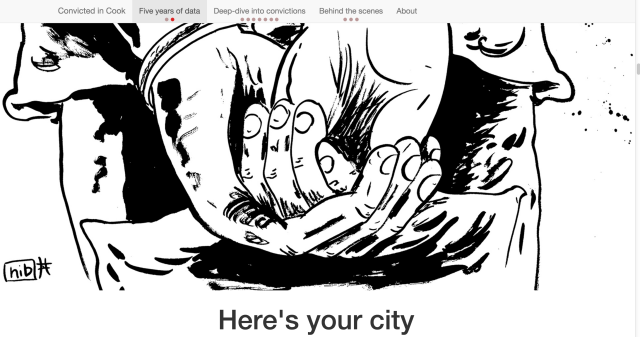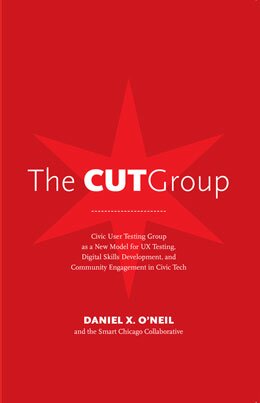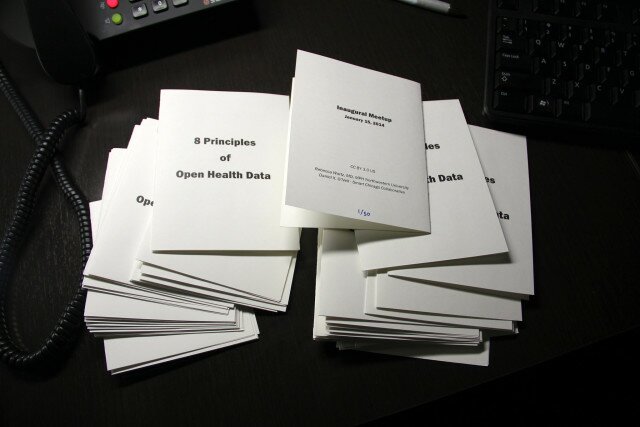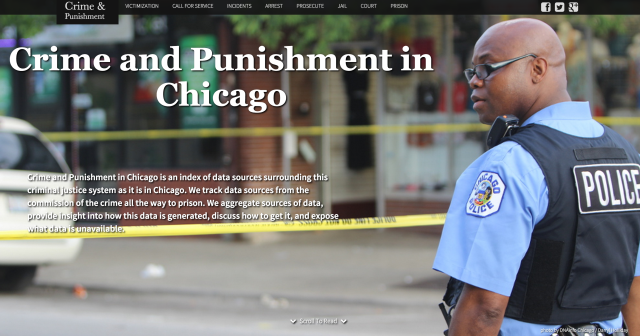Tonight Sonja Marziano presented at The Chicago Community Trust President & CEO Terry Mazany’s Special Topics: Social Enterprise class at Northwestern University. Here’s what we showed:
Month: February 2015
Crime, Data, Justice
I have worked worked with a lot of crime data from a lot of cities, going back almost 10 years. I’ve worked with hundreds of colleagues to get more crime data published, make apps based on crime data, and to improve standards around the publication of crime data.
Today’s story in The Guardian, (The disappeared: Chicago police detain Americans at abuse-laden ‘black site’) is a blockbuster piece of journalism that signals a very important day for those of us who care about this work. Here’s an extended snip:
The Chicago police department operates an off-the-books interrogation compound, rendering Americans unable to be found by family or attorneys while locked inside what lawyers say is the domestic equivalent of a CIA black site.
The facility, a nondescript warehouse on Chicago’s west side known as Homan Square, has long been the scene of secretive work by special police units. Interviews with local attorneys and one protester who spent the better part of a day shackled in Homan Square describe operations that deny access to basic constitutional rights.
Alleged police practices at Homan Square, according to those familiar with the facility who spoke out to the Guardian after its investigation into Chicago police abuse, include:
- Keeping arrestees out of official booking databases
- Beating by police, resulting in head wounds.
- Shackling for prolonged periods.
- Denying attorneys access to the “secure” facility.
- Holding people without legal counsel for between 12 and 24 hours, including people as young as 15.
A day like this makes me proud of what we do and the way we do it.
At Smart Chicago, we’ve never made a crime report app. In our Justice program, we focus on access to data (not just display), youth-led tech (rather than data-driven apps), and websites that delve into published and unpublished datasets about incarceration (so that we can go beyond the data handed down and try to see what’s still left behind).
I’m particularly proud of two justice-centered technology projects we’ve published over the last year, with our partners the Chicago Justice Project and FreeGeek Chicago’s Supreme Chi-Town Coding Crew. I think these projects are exemplary apps in a post-Homan Square civic tech world.
They don’t display official crime data. Instead, Crime and Punishment in Chicago focuses (like the Guardian story) on what *isn’t* published.
Here’s our description:
All over Chicago, every day, in every corner of our oblong city, people commit crimes. This project is an index of the data that documents these crimes and what, if any, response there is from the criminal justice system.
The documentation is immense. Some is published. Much of it is not. Our goal is to create a flat, simple guide to what is known and what is not.
We haven’t waited for data to hit the data portal— we work with hard-nosed people like Tracy Siska who get a hold of never-before-published conviction data through FOIA. This data is displayed in Convicted in Cook.

Here’s our description:
This project is an analysis of five years of Cook County conviction data. The information was received by Tracy Siska of the Chicago Justice Project from the Office of the Chief Judge of the Circuit Court of Cook County through a request to the chief judge. We’ve posted a copy of that request here.
Each year, tens of thousands of people stand in front of judges at the Cook County Circuit Court, the largest unified court system in the country. Their offenses range from marijuana possession charges that result in low-level misdemeanor convictions to multiple murders that put people behind bars for life.
When a violent crime is picked up by the news media, it’s often sensationalised so that every minor detail is brought into the public purview. Meanwhile, the vast majority of convictions – mostly drug related – are given little notice.
This project will attempt to answer several questions regarding convictions in Cook County. Upon first receiving the data, it became apparent that the data was messy and incomplete.
Two projects that use technology and data to zero in on justice, not tech projects that zero in on crime data. As we’ve seen in today’s news, published an ocean away from the corner of Homan and Fillmore, the only way past messy and incomplete is more work. So: onward.
Toward a Municipal Ping Service
 The death of RSS (Real Simple Syndication) has made the Web less fluid. This is not a good thing. The good thing is that American cities are uniquely positioned to make a dent in this trend.
The death of RSS (Real Simple Syndication) has made the Web less fluid. This is not a good thing. The good thing is that American cities are uniquely positioned to make a dent in this trend.
The popularity of this recent tweet by my colleague Harper Reed is a good indication of yearning for a generic subscription system for content updates:
i miss @google reader
— harper (@harper) February 8, 2015
Alongside the demise of RSS is the rise of proprietary timeline systems like Facebook and Twitter. This is a poor substitute because 1/ the systems are not universal and 2/ those systems are closed to aggregation, remixing, and analysis.
Cities can be at the center of part of a solution. 81% of people in the United States live in cities & surrounding suburbs, and this number continues to grow. This approaches some level of universality of experience, since interaction with businesses in these places make up a large percentage of the American experience. This includes every school, restaurant, coffee shop, parking spot, store. It covers nearly every review on Yelp, every check-in on Foursquare, any post of Facebook that relates to a business or organization located in a specific place.
Each municipality has rules, regulations, and processes governing the creation and maintenance of businesses. More importantly, each municipality has issued each business a unique ID (a “handle”) to which it can be referred, but never is. Whether it is a building permit, a liquor license, or a certificate of occupancy, there are amazingly detailed records on every business in every city of size.
These handles could be used as a trusted reference point for all other services. The overall repository of these numbers can then serve as a central, trusted repository for all other services to reference.
What if every review on Yelp, every Google Places page, every Facebook post that referenced a business, had this unique ID embedded in it in some way? And if all of these systems allowed for all of this disparate data to be aggregated into a complete view of the place? What if you could reference a location when making a service request? “The snow in front of Business 127 hasn’t been shoveled in three days”. Or, as a private business, you could lookup everything a city knows about a place. If it could be integrated with existing services like Open Table (“new tomatoes delivered to Restaurant 77. That means that the Fried Green Tomatoes special is on the menu”.) Unlimited.
It could be the trusted external source, not owned by any proprietary system. And it could be a platform upon which cities can start using their public data stores in more meaningful ways.
CUTGroup is an Ash Center Bright Idea 2015
 Today the Ash Center for Democratic Governance and Innovation at the John F. Kennedy School of Government, Harvard University, recognized today our CUTGroup program as part of the 2015 Bright Ideas program. Here’s their citation:
Today the Ash Center for Democratic Governance and Innovation at the John F. Kennedy School of Government, Harvard University, recognized today our CUTGroup program as part of the 2015 Bright Ideas program. Here’s their citation:
Civic User Testing Group
City of Chicago, ILThe Civic User Testing Group is a set of Chicago residents who get paid to test civic apps. Smart Chicago works with residents and civic tech developers to make and test software that helps improve quality of life for residents. Members receive training on basic technology skills, provide feedback, and perform beta-testing on apps and government websites.
Note: Smart Chicago’s Foodborne Chicago product was also recognized this year as a Top 25 Innovation in Government by the Ash Center.
Smart Chicago and the Concept of “Patient Centered”
 We have a number of health programs here at Smart Chicago, all of which are run by my colleague, Kyla Williams. In working on these projects, I’ve come across a number of intriguing concepts, just like one would in any sub-speciality. Chief of these concepts, for me, is “patient-centered”.
We have a number of health programs here at Smart Chicago, all of which are run by my colleague, Kyla Williams. In working on these projects, I’ve come across a number of intriguing concepts, just like one would in any sub-speciality. Chief of these concepts, for me, is “patient-centered”.
To me, a phrase like this is a tell. Any time an industry, company, or organization starts talking about “user-driven”, “customer-focused”, or “patient-centered” strategies, it is an indication that they’ve not been driven, focused, or centered in that direction in the past.
I’ve spent the majority of my career in the world of developing Web sites. In that sub-specialty, the idea of being focused on users is pretty much all there is. If you don’t have users, if you’re not making something that appeals to them and serves their needs, you’ve got nothing.
I don’t have any particular insight into the healthcare industry, since I’ve never worked in it. I can tell you from personal experience as a consumer of healthcare and as a general observer of pop culture, however, that I’ve never felt that patients were at the center of the experience.
Patient portals seem designed to deliver as little information as possible and optimize for medical professionals. Exporting information to give to other caregivers is cumbersome. Integration with email is weak— you have to log in to the system to get even the most innocuous information, like the details of a visit you just scheduled over the phone.
In 2015, we are embarking on and expanding a number of initiatives designed to get us deeper into the patient-centered trend. Our CUTGroup methodology is a recognized as a leading way to gather and act on the feedback of regular residents. The Smart Health Centers model, where we help place trained health information specialists in clinics to assist patients in connecting to their own medical records and find reliable information about their own conditions, is deeply patient-centered. Our Health Data Liberation Meetup Group is at the conceptual forefront for patient control
We think we have a lot to offer, and we’re excited about the work to come.
Help Wanted: Administrative Assistant at Smart Chicago Collaborative
 The Smart Chicago Collaborative is hiring an administrative assistant to help us support our work.
The Smart Chicago Collaborative is hiring an administrative assistant to help us support our work.
The Administrative Assistant will help us with coordinating schedules, requests for information, meetings, and events that surround our work. This may sound simple, but as a collaborative organization we work with a ton of consultants, partners, and funders to get everything done. Throughout the course of our work, we try to keep everything documented and are looking for additional help to do that.
We’re looking for somebody that has at least two years of experience and great web, writing, and communication skills. As a technology outfit, our ideal candidate would be somebody who is interested in technology and not afraid to try out new tools.
More importantly, we’re looking for somebody who is community service oriented. Our work centers around using technology to create an impact in our communities and we’re looking for somebody who wants in the game.
PHOTOS: CUTGroup #14, Chicago Cityscape, Logan Square Public Library
Here’s a set of images of Sonja Marziano, Christopher Whitaker, and Josh Kalov conducting CUTGroup #14, which is focused on Chicago Cityscape, a site that tracks building permits, violations, and historic resources in all neighborhoods, community areas, and wards using open data.
Developer Steve Vance conducted a number of the tests, along with guest proctor Daniel Ronan.
Thirteen testers from all over the city showed up on a cold winter night, and we all learned a lot. Sonja is compiling the results— full report soon!
See a complete collection of photos from CUTGroup tests here.
“Hacking Design Research” Interview in Civic Quarterly
Here’s an interview in Civic Quarterly about the CUTGroup. Snip:
Part civic duty, part solicited opinion, Smart Chicago’s CUTGroup is comprised of “regular Chicago residents who get paid to test civic apps.” This, in turn, allows developers to get citizen feedback on demand and learn how well their civic technology works when put through its paces.
In the Fall of 2014, O’Neil published a book chronicling the creation and execution of Smart Chicago’s CUTGroup. After giving it a read, I reached out for some clarification. As a formerly private-sector user experience designer turned public-sector advocate, I wondered how Smart Chicago’s approach differed from the design research methods I was more familiar with.
